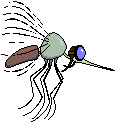



| Sequence Source Links | ||||||
|
||||||
| Database Satistics | |||
|
|||
| Dengue Fever | |
Dengue fever is a disease caused by a virus that is transmitted by mosquitos. It is an acute illness of sudden onset that usually follows a benign course with headache, fever, prostration, severe joint and muscle pain, swollen glands (lymphadenopathy) and rash. The presence (the "dengue triad") of fever, rash, and headache (and other pains) is particularly characteristic of dengue. Dengue (pronounced DENG-gay) strikes people with low levels of immunity. An attack of dengue produces immunity for a year or more. Once this outbreak ebbs, more people will be resistant to the viral disease and the cycle will begin again. Dengue goes by other names including breakbone or dandy fever. Victims of dengue often have contortions due to the intense joint and muscle pain. Hence, the name "breakbone fever." Slaves in the West Indies who contracted dengue were said to have "dandy fever" because of their postures and gait. |
|
Top..... |
|
| ..........What areas are at high risk for contracting Dengue fever? | |
Dengue is endemic throughout the tropics and subtropics. Outbreaks have, for example, occurred in the Caribbean, including Puerto Rico, the US Virgin Islands, and Cuba. Cases have also been imported via tourists returning from areas with endemic dengue including Tahiti, the South Pacific, SE Asia, the West Indies, India and the Middle East. Dengue fever is thriving elsewhere in SE Asia. Thailand, Vietnam, Singapore and Malaysia have all reported an increase in cases. In Thailand, dengue fever killed 31 people in the first three months of 1998. |
|
Top..... |
|
| ..........How is dengue contracted? | |
It comes from a virus (the dengue virus) carried by the striped Aedes aegypti mosquito. The mosquito flourishes during rainy seasons but can breed in water-filled flower pots, plastic bags and cans year round. One mosquito bite can inflict the disease. The incubation period ranges from 3 to 15 (usually 5 to 8) days before the signs and symptoms of dengue appear. |
|
Top..... |
|
| . ........What are the signs and symptoms of dengue? | |
Dengue starts with chills, headache, pain upon moving the eyes, and low backache. Painful aching in the legs and joints occurs during the first hours of illness. The temperature rises quickly as high as 104? F (40? C), with relative low heart rate (bradycardia) and low blood pressure (hypotension). The eyes become reddened. A flushing or pale pink rash comes over the face and then disappears. The glands (lymph nodes) in the neck and groin are often swollen. |
|
Top..... |
|
| ...........What is Dengue hemorrhagic fever? | |
Dengue hemorrhagic fever (DHF) is a specific syndrome that tends to affect children under 10. It causes abdominal pain, hemorrhage (bleeding) and circulatory collapse (shock). DHF is also called Philippine, Thai, or Southeast Asian hemorrhagic fever and dengue shock syndrome. |
|
Top..... |
|
..........How can dengue fever be prevented? |
|
The transmission of the virus to mosquitoes must be interrupted to prevent the illness. To this end, patients are kept under mosquito netting until the second bout of fever is over and they are no longer contagious. |
|
Top..... |